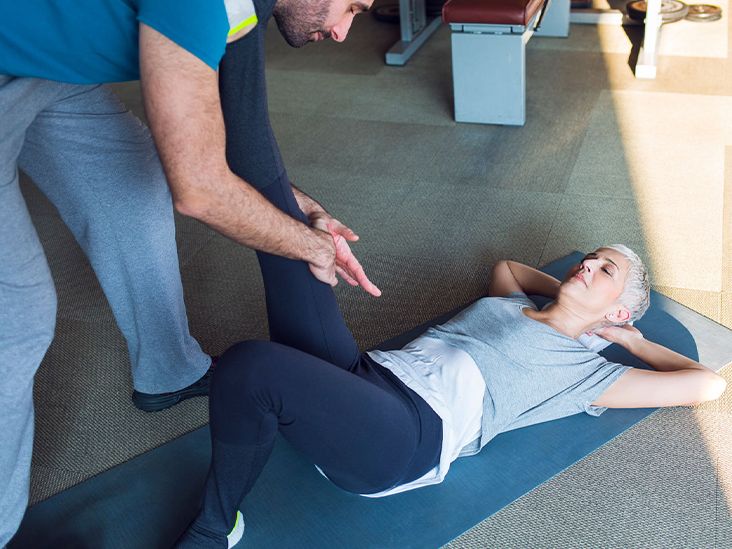If you have multiple sclerosis (MS), some exercises may help maintain and improve your balance, muscle tightness, and overall well-being. These can include stretches and exercises to do while lying down, seated, or standing with support.
Exercise and physical activity are important to your health and well-being. If you have MS, exercise may not be as easy as it once was. Water exercise, home workouts, physical therapy, and other options can help you maintain and enhance both your physical functioning and your mental wellbeing with MS.
However, certain stretches and exercises can help increase your fitness levels and improve your balance and coordination. According to a 2020 study, people with MS should aim to get 150 or more minutes of exercise per week, or 30 minutes on five days each week.
A plan that will suit you will depend on your specific capabilities and needs. For this reason, it’s best to speak with your doctor before starting an exercise program, and they will help you.
Here we show you some exercises that may help. Remember to take it slowly, build up gradually, and always rest between exercises.
Stretching can help improve balance and coordination. It’s also easy for people of all physical activity levels. Some experts recommend stretching for 10 to 15 minutes a day if you have MS.
Stretching can help improve your posture and prevent aches and pains associated with MS. Gentle stretching can also help warm up muscles for movement. This is important if you’ve been inactive for a while.
Warming up and slowly moving your muscles will also help prevent torn muscles, strains, and sprains. Stretch after you wake up or after sitting for long periods of time. Seated stretching is easier and safer for beginners.
Strengthening or warm-up exercise: Hip marching
- Sit in a sturdy chair with your back touching the back of the chair.
- Place your hands comfortably on your legs.
- Slowly lift your left leg straight up, leaving the knee bent.
- Hold for a count of 5 (or as long as comfortable), and then return your foot to the floor.
- Repeat with the other leg.
Pilates may be good for someone with early symptoms of MS. A 2022 study showed that it’s a safe treatment option with few side effects and high adherence rates. Specifically, it can help improve balance, walking ability, physical function, and even cognitive functions.
Certified personal trainer Dani Singer recommends roll-ups to activate abdominal muscles responsible for stabilizing the spine.
Pilates exercise: Roll-ups
- Lie down on a mat with your legs straight. Reach overhead and hold the end of the mat with your fingertips.
- Exhale and try to pull your stomach in towards the floor.
- Still holding onto the mat, slowly peel the shoulder blades and upper back off the floor, while gently pushing the head back into the mat.
- Pause for 2 seconds, trying to feel that contraction in the abdominals.
- Slowly reverse the movement, lowering the upper back down to the floor.
Spasticity is one of the more common symptoms of MS. The condition can range from mild muscle tightness to pain or tightness in and around joints, to uncontrollable spasms of extremities, usually of the legs.
The Achilles tendon release helps release tension in the soleus, a calf muscle that is primarily used for pushing off the ground while walking. Oftentimes, people with MS experience limited mobility when this muscle gets stiff, Singer says.
Spasticity exercise: Achilles tendon release
- While seated in a chair or on the floor, extend one leg and wrap a band or strap around the ball of that foot.
- Lengthen your spine by sitting up tall and gently pulling your stomach in toward your spine.
- Maintaining that upper body posture, slowly pull on the band or strap, pulling your foot back toward you. The movement should occur at the ankle joint, lengthening the overactive muscles in the back of the lower leg and heel.
To help strengthen the leg muscles, the assisted butt kick requires assistance from a practitioner, friend, or family member, Singer says.
Leg exercise: Assisted butt kicks
- Stand and hold onto the back of a chair with both hands for support.
- Lift your heel back behind you and try to touch your butt. The movement should occur at the knee joint.
- When you can’t get any higher, have a friend gently assist you with their hands to lift your heel as high as possible, without discomfort.
- Lower your foot back down to the ground as slowly as possible.
Assisted split squats
- Stand and hold the back of the chair with both hands for support.
- Keep one foot in line with your trunk, behind the chair.
- Place the other foot around 18 inches to 2 feet behind.
- Keeping your front foot flat on the floor, slowly lower yourself so that your front leg bends as close to 90 degrees as you can.
- Hold for a moment, then gently lift yourself, using the chair for balance.
- Rest for 15 seconds then swap legs.
- Bring both feet together again.
For this exercise and more leg exercises, see the following video:
Stiffness in the shoulder girdle can be a big cause of pain and immobility for people with MS, occupational therapist Brittany Ferri says. By doing arm raises to stretch the shoulder joints, you’re working to keep the joints lubricated so they can remain loose and flexible.
Chair exercise: Arm raise
- While sitting in a chair with your spine straight and tall against the back of the chair, move one arm out to your side.
- Bring that same arm all the way out and up over your head while keeping your entire arm straight.
- Once your arm is above your head, hold it there while taking a full, deep breath in, and letting that same breath out.
- Bring your arm back down to rest at your side.
A
Personal trainer and nutrition coach Tim Liu recommends standing row exercises to strengthen postural muscles.
Weight training exercise: Standing row
- Wrap an exercise band around a pole or rod and grab the handles of the band. Take a few steps back from the pole.
- Keeping your core tight with your knees soft, pull the handles toward you until your shoulders are in line with your elbows.
- Squeeze your shoulder blades together, then straighten your arms back to starting position.
Exercise and physical activity can help manage many symptoms of MS. Studies have shown that aerobic exercise programs for people living with MS can improve:
- cardiovascular fitness
- strength
- bladder and bowel function
- fatigue
- mood
- cognitive function
- bone density
- flexibility
Some people with MS might overheat quickly when exercising, while others may experience balance issues or their legs may begin to tingle, says Chris Cooper, a certified personal trainer who has worked with people with MS.
Here are some tips to help reduce the risk:
- Speak with a doctor or physical therapist before starting an exercise program, to check it is right for you.
- Keep a bottle of water nearby for rehydration.
- Take your time and build up slowly.
- Take breaks of 15 seconds or longer between activities.
- If possible, exercise when someone else is around, especially when you first start.
Exercises that improve muscle strength and balance can help boost your ability to walk with MS. If you experience numbness, a mobility aid like a cane might be useful. Stretching, exercise, and medication can help manage muscle tightness and spasms and might be useful for balance.
Finally, mobility devices and adjustments around the home, such as ramps, can help manage a fear of falling.
While you may feel that using a mobility device means you have “given in,” it actually allows you to get out in the community and participate in life events on which you may otherwise miss out.
MS usually follows a pattern of flares and remission. While you may have difficulty walking during a flare, you may find you are able to walk again during times of remission. Physical therapy can help you maintain your walking ability and may help regain it when you think it is lost.
Researchers are looking into new techniques, such as electrical implants, to help people regain walking ability even with severe MS.
A range of exercises can help you improve leg strength while living with MS. Examples include hip marching, assisted butt kicks, and assisted split squats.
Various features of MS can make it hard to walk. They include muscle weakness, muscle tightness and spasms, problems with balance, and the fear of falling itself. Doing exercises can help you boost your confidence and maintain your strength and flexibility for walking.
An exercise program may need to be adjusted as changes occur in MS symptoms. Consult with a physician before starting a new exercise program.












